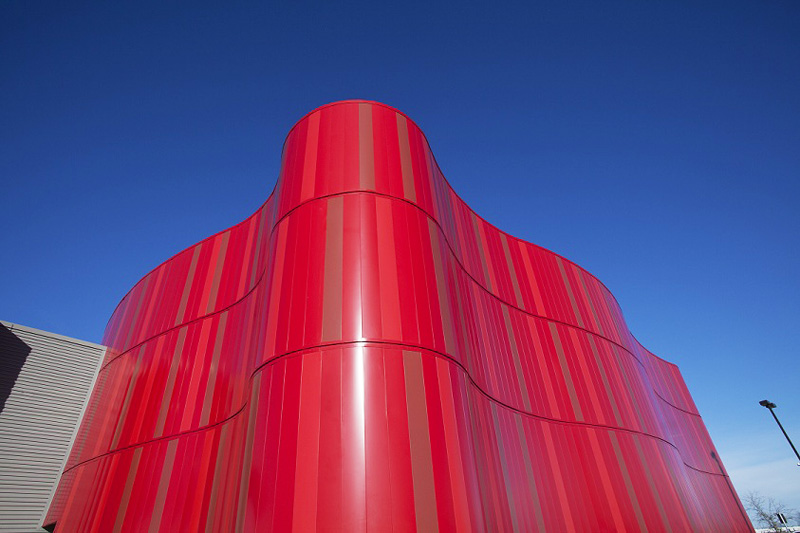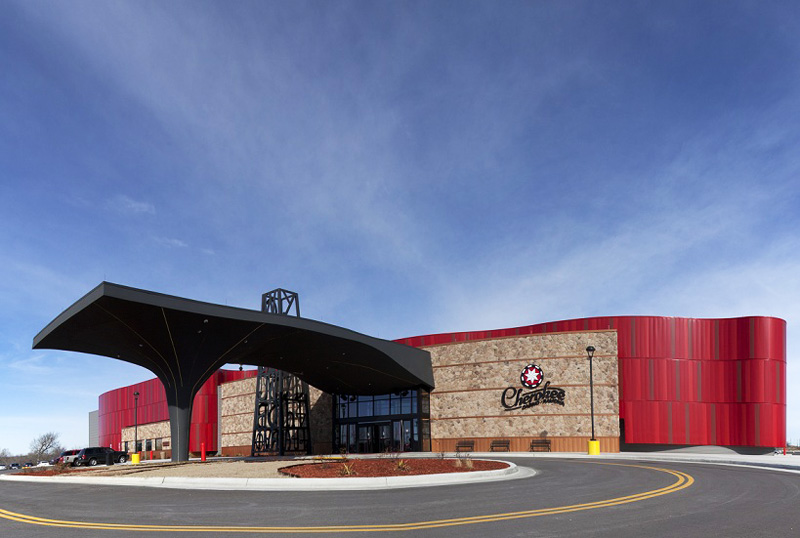Cherokee Nation Entertainment’s 10,000-sq.-ft. Ramona Casino features a unique style that was both challenging and rewarding to create. The curved nature of the building’s exterior required multiple shades and profiles of metal panels, plus clever installation work by the contractor, Abbco Roofing in Broken Arrow, Okla., which was up to the challenge.
Located in Ramona, Okla., the casino was built on a 20-acre site near an existing casino. Selser Schaefer Architects in Tulsa, Okla., developed a phased master plan that enabled consistent casino operations in a temporary facility, while the permanent facility was completed. Because Ramona is where the first commercial oil well was drilled in what would become Oklahoma, the casino’s design is reminiscent of the time period from 1887 to 1906. Two oil derricks at the casino’s main entrance signify the beginning of the petroleum industry.

Selser Schaefer Architects states that the curved building form relates to the fluidity of oil, while breaking down the general rectangular floor plan to create a more appealing look from the nearby highway. Material choices such as copper panel and field stone were selected for Cherokee Nation cultural significance as well as function. The design of the casino and its concert venue incorporates clean lines and straight-forward materials. The interior colors and textures reflect the cultural integrity of the oil boom time period. Slate and copper ceiling elements create an exciting environment that permeates the entire gaming floor.
Abbco Roofing completed the metal panel work for this architecturally unique project, including the installation of wall and soffit panels in a pattern that features multiple shades of red. “The walls, as you can see, were curvilinear, and both concave and convex in style. The reveal detail was the biggest challenge by far,” says Dave Stanley, owner, Abbco Roofing.
“The reveal detail looked like a hat channel recessed in the wall and had to curve with the wall. This could not be roll-formed. We made the reveal in 10-ft. lengths in the shop and then turned the hat up and saw-cut it to enable us to bend it to the wall. The bottom of the hat then showed the saw joints and we covered it with flat metal to conceal the joints,” Stanley explains.
The design process at Selser Schaefer is always collaborative, and the firm works to bring its clients the value of timeless, sustainable architecture that does good things for people, communities and the environment. This project is no exception; everyone came together to develop a project that balances the functional needs and goals with an elegantly designed casino.
The general contractor was RM Builders of Muskogee, Okla. Petersen Aluminum metal panels were manufactured in Petersen’s Tyler, Texas, plant. Abbco has used Petersen Aluminum since 1974. “Trust, loyalty and the ease of the working relationship has to be superior in every fashion, and the support I get from the Tyler, Texas, facility is great,” Stanley says.

The new casino includes the following Petersen Aluminum products: 1,022 sq. ft. of 12-in perforated flush panel in Colonial Red; 20,436 sq. ft. of 12-in. 24-gauge flush panel in custom Bright Red and Copper Penny with stiffening beads; 11,033 sq. ft. of 16-in. 24-gauge horizontal wall panel in Slate Gray; 360 sq. ft. of 36-in. 7.2 panel in 24 gauge Slate Gray; 6,596 sq. ft. of 24-gauge 7/8-in. corrugated in Slate Gray; 13,120 sq. ft. of flat sheet in 24 gauge and custom Bright Red, Copper Penny and Slate Gray.
When the project was completed, Stanley had time to step back and observe what Abbco had accomplished. “It dawned on me how special it was and how proud I was to be involved, and of our crew’s hard work,” he says.
Related Stories
| Jan 14, 2016
How to succeed with EIFS: exterior insulation and finish systems
This AIA CES Discovery course discusses the six elements of an EIFS wall assembly; common EIFS failures and how to prevent them; and EIFS and sustainability.
Sponsored | Coatings | Aug 25, 2015
Cherokee Casino Ramona reflects oil history in Indian territory
The eye-catching façade is a tribute to the area's rich oil history.
| Jan 2, 2015
Construction put in place enjoyed healthy gains in 2014
Construction consultant FMI foresees—with some caveats—continuing growth in the office, lodging, and manufacturing sectors. But funding uncertainties raise red flags in education and healthcare.
| Dec 28, 2014
AIA course: Enhancing interior comfort while improving overall building efficacy
Providing more comfortable conditions to building occupants has become a top priority in today’s interior designs. This course is worth 1.0 AIA LU/HSW.
| Oct 16, 2014
Perkins+Will white paper examines alternatives to flame retardant building materials
The white paper includes a list of 193 flame retardants, including 29 discovered in building and household products, 50 found in the indoor environment, and 33 in human blood, milk, and tissues.
| Oct 12, 2014
AIA 2030 commitment: Five years on, are we any closer to net-zero?
This year marks the fifth anniversary of the American Institute of Architects’ effort to have architecture firms voluntarily pledge net-zero energy design for all their buildings by 2030.
| Sep 24, 2014
Architecture billings see continued strength, led by institutional sector
On the heels of recording its strongest pace of growth since 2007, there continues to be an increasing level of demand for design services signaled in the latest Architecture Billings Index.
| Sep 22, 2014
4 keys to effective post-occupancy evaluations
Perkins+Will's Janice Barnes covers the four steps that designers should take to create POEs that provide design direction and measure design effectiveness.
| Sep 22, 2014
Sound selections: 12 great choices for ceilings and acoustical walls
From metal mesh panels to concealed-suspension ceilings, here's our roundup of the latest acoustical ceiling and wall products.
| Sep 9, 2014
Using Facebook to transform workplace design
As part of our ongoing studies of how building design influences human behavior in today’s social media-driven world, HOK’s workplace strategists had an idea: Leverage the power of social media to collect data about how people feel about their workplaces and the type of spaces they need to succeed.















